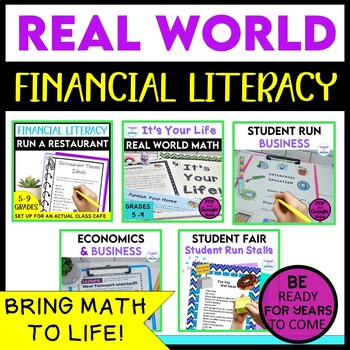Financial Literacy Project Bundle Grades 5 to 9 | Economics and Business
- Zip
Products in this Bundle (5)
Description
Do you want your students to learn financial literacy skills and budgeting in a real life settings? Students will beg to keep learning when they participate in these FUN projects. This bundle will have you covered for YEARS to come...
It is SO IMPORTANT that our students learn the vital skills of financial literacy these days. They need to know the value of money and how marketing can influence them.
By purchasing this bundle you will SAVE 30% off the individual price of each listing...price will go up as more products are added.
In this bundle you will have all your guides and worksheets to help you set up and run a range of hands on projects including:
- Run a Fair - (set up student businesses to be run on a special school day)
- Run a Class Cafe/ Restaurant - (Imagine the excitement on your student's faces when they turn their classroom into a cafe for their parents/ grandparents/ another class).
- Student Run Business - (students set up and run a business for a set time frame - often 10 weeks but could be shorter/ longer).
- It's Your Life - (a research project where students need to choose a job and budget around the finances in their life)
- Business and Economics - (designed to have students learn more about the terms and essentials of being both a customer and a business owner)
Each resource includes:
- Easy set up for teachers
- Ideas to help you get started
- Worksheets for students
- Ready to use assessment
- ALSO AVAILABLE AS GOOGLE SLIDES
These projects have been made to help students learn important Business and Economics, and is suitable for any grade 5 to 9 class.
View each resource individually:
Classroom Re-design Math Project
~~~~~~ Receive TPT credits to use on future purchases ~~~~~~
Go to your My Purchases page. Next to each purchase you'll see a Provide Feedback button, click it and you will be taken to a page where you can leave a quick rating and a short comment about the product. Each time you provide feedback, you’ll earn TPT credits that can be used for future purchases to save you money! Plus, the feedback you provide helps me make my products better suit your needs!
~~~~~~ How to Follow My Store to receive updates and special deals ~~~~~~
Click the green star beside my name at the top of this page OR at the top of my store page. Following me notifies you when I post a new item and you will receive emails when products are on sale.
Copyright information:
Purchasing this product grants permission for use by one teacher in his or her own classroom. If you would like to share with others, please purchase an additional license.





